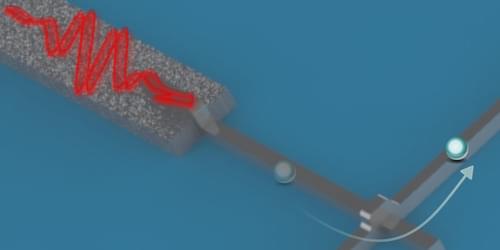A multi-institutional team of environmental scientists has built a computer simulation showing that more than half of all people globally have limited access to safe drinking water. The findings are published in the journal Science.



Peel apart a smartphone, fitness tracker or virtual reality headset, and inside you’ll find a tiny motion sensor tracking its position and movement. Bigger, more expensive versions of the same technology, about the size of a grapefruit and a thousand times more accurate, help navigate ships, airplanes and other vehicles with GPS assistance.
Now, scientists are attempting to make a motion sensor so precise it could minimize the nation’s reliance on global positioning satellites. Until recently, such a sensor — a thousand times more sensitive than today’s navigation-grade devices — would have filled a moving truck. But advancements are dramatically shrinking the size and cost of this technology.
For the first time, researchers from Sandia National Laboratories have used silicon photonic microchip components to perform a quantum sensing technique called atom interferometry, an ultra-precise way of measuring acceleration. It is the latest milestone toward developing a kind of quantum compass for navigation when GPS signals are unavailable.

Researchers have successfully demonstrated negative entanglement entropy using classical electrical circuits as stand-ins for complex quantum systems, providing a practical model for exploring exotic quantum phenomena and advancing quantum information technology.
Entanglement entropy quantifies the degree of interconnectedness between different parts of a quantum system. It indicates how much information about one part reveals about another, uncovering hidden correlations between particles. This concept is essential for advancing quantum computing and quantum communication technologies.
To understand what negative entanglement entropy means, we will first need to know what entanglement and entropy are.


Researchers have uncovered new phenomena in the study of fractional quantum Hall effects.
Their experiments, conducted under extreme conditions, have revealed unexpected states of matter, challenging existing theories and setting the stage for advancements in quantum computing and materials science.
Exploring the enigmatic world of quantum physics.

Like a computer system with built-in redundancies, a study has revealed that brains use three different sets of neurons to store a single memory. The finding could one day help soften painful memories in people who’ve suffered trauma.
By imaging the brains of mice, researchers at the University of Basel’s Biozentrum, were able to watch what happens when a new memory is formed. What they found was that the rodent brains called three different sets of neurons into action to record the memory. The first are known as early-born neurons and are the earliest to develop as a fetus is growing. At the other end of the spectrum are the late-born neurons, which show up late in embryonic development. Between these are neurons that form somewhere right in the middle of growth in the womb.
The imaging study revealed that when the new memory is stored in the early-born neurons, it is initially hard to retrieve, but it becomes stronger as time goes on.

A new device converts a stream of microwave photons into an electric current with high efficiency, which will benefit quantum information technologies.
Technologies for quantum computing, sensing, and communication process information stored in quantum bits (qubits) by using microwave photons. But detecting such photons accurately and at high rates—to read out the changing states of a quantum computer, for example—is a challenge, since they have much less energy than visible or infrared photons. Now researchers have demonstrated a detection method based on the fact that a photon can assist in the quantum tunneling of an electron through a superconducting junction [1]. The technique converts a stream of microwave photons into a flow of electrons far more effectively than other methods, showing an efficiency of 83%, and it will be of immediate use in quantum technologies.
Building good detectors of microwave photons is inherently difficult, says Julien Basset of the University of Paris-Saclay, because such photons lack the energy needed to excite electrons in semiconductors into the conduction band, thereby generating a current that can be measured. Researchers have been pursuing several techniques, but none works well for a continuous stream of photons, in which multiple photons may arrive simultaneously. For such continuous operation, as would likely be required in many practical quantum information devices, the best efficiency demonstrated so far has been only a few percent, Basset says.


Related: SDR: a spectrum of possibilities
NAVWAR awarded the order on behalf of the Navy’s Program Executive Office for Command, Control, Communication, Computers, and Intelligence (PEO C4I) in San Diego.
The AN/USC-61© is a maritime software-defined radio (SDR) that has become standard for the U.S. military. The compact, multi-channel DMR provides several different waveforms and multi-level information security for voice and data communications.

“Not being able to communicate is so frustrating and demoralizing. It is like you are trapped,” Harrell said. “Something like this technology will help people back into life and society.”
For the researchers involved, seeing the impact of their work on Harrell’s life has been deeply rewarding. “It has been immensely rewarding to see Casey regain his ability to speak with his family and friends through this technology,” said the study’s lead author, Nicholas Card, a postdoctoral scholar in the UC Davis Department of Neurological Surgery.
Leigh Hochberg, a neurologist and neuroscientist involved in the BrainGate trial, praised Harrell and other participants for their contributions to this groundbreaking research. “Casey and our other BrainGate participants are truly extraordinary. They deserve tremendous credit for joining these early clinical trials,” Hochberg said. “They do this not because they’re hoping to gain any personal benefit, but to help us develop a system that will restore communication and mobility for other people with paralysis.”